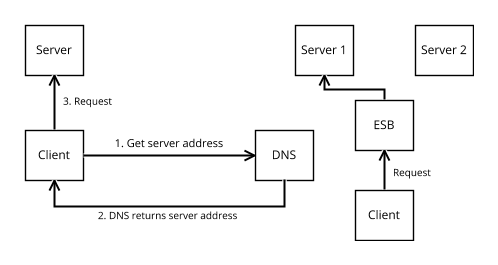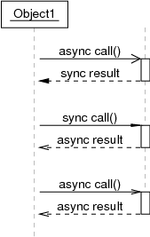Loose Coupling
Jump to navigation
Jump to search
Scalability
- Scalability can be understood as:
- an ability to add new features
- increase the utilization (number of users, requests, the size of data, etc..) of an existing system
- Minimizing the impact of modifications and failures on the system landscape as a whole
- Maintainability
The Need for Fault Tolerance
- No time for well-elaborated, robust system designs.
- Changing requirements
- A flight booking system failure may cost $100,000 an hour, a credit card system breakdown may cost $300,000 an hour, and a stock-trading malfunction may cost $8 million an hour.
Loose Coupling
- The aim of loose coupling is to minimize dependencies.
- When there are fewer dependencies, modifications to or faults in one system will have fewer consequences on other systems.
- Loose coupling is a principle; it is neither a tool, nor a checklist
Forms of loose coupling
| Tight Coupling | Loose Coupling | |
|---|---|---|
| Physical connections | Point-to-point | Via mediator |
| Communication style | Synchronous | Asynchronous |
| Data model | Common complex types | Simple common types only |
| Type system | Strong | Weak |
| Interaction pattern | Navigate through complex object trees | Data-centric, self-contained message |
| Control of process logic | Central control | Distributed control |
| Binding | Statically | Dynamically |
| Platform | Strong platform dependencies | Platform independent |
| Transactionality | 2PC (two-phase commit) | Compensation |
| Deployment | Simultaneous | At different times |
| Versioning | Explicit upgrades | Implicit upgrades |
Asynchronous Communication
- The systems exchanging service messages do not have to be online at the same time
- Long answering times don’t block the service consumer
- Logic of the service consumer gets (much) more complicated
Heterogeneous Data Types
- Systems can modify their data types without directly affecting other systems (modified service interfaces affect only corresponding consumers)
- You have to map data types from one system to another
Mediators
- First type is when sender may know the physical address of the called system (broker or name server). You ask for a service using a symbolic name, and the broker or name server.
- The second type chooses the right endpoint for a request after the consumer sends it. The consumer sends the request to a symbolic name, and the infrastructure (network, middleware, ESB) routes the call to the appropriate system.

Weak Type Checking and Binding
- Early and late binding
- Generic ESB
- ESB isn't coupled with any of the systems
- only general statistics
- general routing
- Type specific ESB
- Details statistics
- Routing based on specific conditions (type, value in a element, source, etc..)
- There is a dependency between the type and the ESB
Interaction Patterns
- Are only strings supported, or can other fundamental data types (integers, floats, Booleans, date/time types, etc.) be used?
- Are enumerations supported?
- Can you constrain possible values (e.g., define certain string formats)?
- Can you build higher types (structures, records)?
- Can you build sequence types (arrays, lists)?
- Can you design relations between types (inheritance, extensions, polymorphism)?
Compensation
- Two-phase commit (2PC)
- If only one modification is successful, you then “compensate” for the problem appropriately
- System updates don’t have to be performed synchronously
- You have to explicitly provide and call services that revert previous services or programs for manual error handling
- BPEL supports compensation
Control of Process Logic
- Process-control decisions can also lead to different forms of coupling. Having one central component controlling the whole process logic creates a bottleneck because each involved system must connect with it (Orchestration, BPM)
- Decentralized or distributed control (where each component does its job and knows which component will continue after) you avoid bottlenecks (Choreography, CEP)
Deployment
- Simultaneous deployment creates dependency
- The more loosely coupled approach of updating at different times, however, leads to a very important drawback: the need for migration, which leads to versioning
Versioning
With a more loosely coupled form of data type versioning, the consumer won’t have to do anything as long as the modifications are backward compatible.
Summery
- Loose coupling is a fundamental concept of SOA aimed at reducing dependencies between different systems.
- There are different forms of loose coupling, and you will have to find the mixture of tight and loose coupling that’s appropriate for your specific context and project.
- Any form of loose coupling has drawbacks. For this reason, loose coupling should never be an end in itself.
- The need to map data is usually a good property of large systems.

